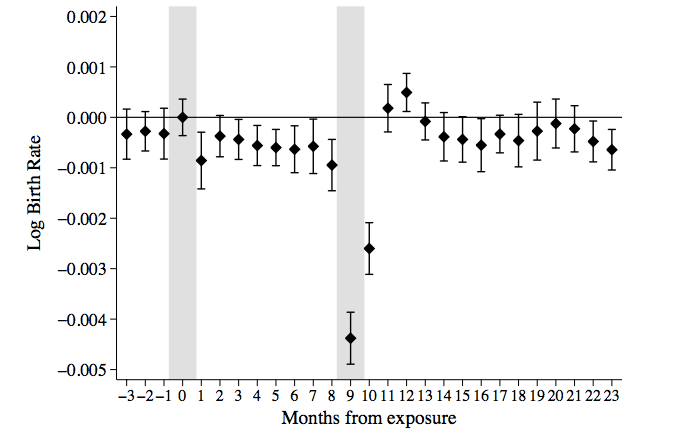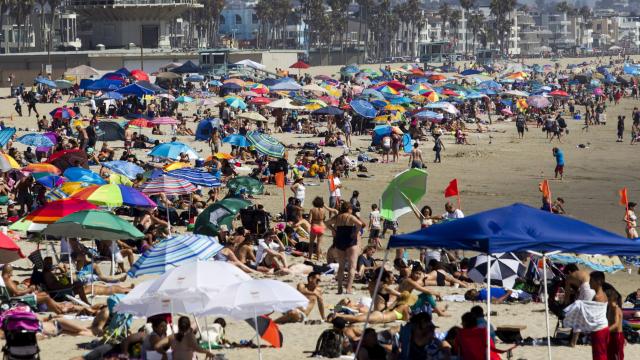Three researchers at the National Bureau of Economic Research have published a working paper showing how increasing temperatures over the next century could mean fewer babies born — because, to paraphrase Cole Porter, it will be too darn hot.
Did you know that just one day over 26C is correlated with a .4 per cent decrease in birthrates nine months later? Yep — just a moderately hot day can have a “large and statistically significant” effect on rates of birth, say Tulane University’s Alan Barreca, UC Santa Barbara’s Olivier Deschenes, and the University of Central Florida’s Melanie Guldi. Together, the trio are working on extrapolating that known effect into our super-heated future climate in a working paper called Maybe Next Month? Temperature Shocks, Climate Change, and Dynamic Adjustments in Birth Rates.
The trio studied this effect using the biggest dataset of birth rates and temperature records available, spanning across the US from 1930 to 2010. They compared temperature fluctuation over those 80 years, looking at state-by-state data to account for region differences (for example, the South has way more days over 26C, and births tend to spike in September compared to the rest of the country) as well as other things that could effect birth rate — for example, how summertime planting season could prevent people from having sex during those months.

Effect of daily mean temperature >80 F relative to 60-70 F on log birth rate , by exposure month, Barreca et al.
With each temperature spike, they looked at how birth rates were effected eight, nine, or ten months later. Eight months after a heat spike, birth rates had decreased by .06 per cent. Nine months after, it was a much larger .39 per cent decrease, or about 1,165 fewer births. Ten months later, the number goes back down to .21 per cent fewer births. Fascinatingly, they also describe a “rebound effect,” where 11 to 13 months after a heat spike they saw a marked increase in births — as though people had until cooler weather to conceive, whether cognisant of it or not.
Oh, and air conditioning? That changed things too: By the 1970s, as a/c became more common in houses across the US, the heat effect gets “dampened,” as they show here:

Daily Birth Rate per 100,000 Residents, 1931-2010, by time period, Barreca et al.
Then, using a future scenario where climate change continues unabated at its current levels, they extrapolated the observed effects of heat and birth rate from the present to 2099.
What they found — and keep in mind, as a working paper, this data hasn’t yet been peer-reviewed — was a predicted 2.6 per cent decline in births in the future — put in birth terms, 107,000 fewer births. Broken down by region, the Northeast will be the most affected with a 3.2 per cent decrease, followed by the Midwest at 2.8 per cent, and the South by 2.8 per cent. They say the West will be the lease affected, with only a 2.2 per cent decrease. Another result: People will have sex in later months than they typically do now, meaning seasonal birthrates will shift one month later, too.
They also have plenty of caveats: These predictions don’t assume any kind of large-scale migrations, which could shift the effects. They also don’t show how humans might adapt to increased heat over time, rather than the “spikes” that this data is based on. What’s more, air conditioning might simply be more ubiquitous, and we may see the spike effect diminish. It’s also possible that their analysis of existing data overlooks some other causations — like the advent of popular birth control, or demographic and workforce changes, which also may have altered birth rates in the 1970s.
So this data is still open to criticism, as a working paper, and we can take it with some scepticism as one possible scenario rather than a solid prediction. Again, correlation is not necessarily causation. But the authors point out that if their future scenario does come true, there could be real hazards. For example, they note that if humans adjust to the heat by conceiving more often in the fall instead of the summer, those babies would be born in the dangerous heat of the mid-summer rather than the spring.
So not only will the overall US population fall by roughly 107,000 births every year, but more babies will be at risk for low birth weight and other health effects of being exposed to high temperatures in utero and as infants. But again, it’s worth reading that warning with some scepticism, since the effects of heat on birth aren’t clear — especially in parts of the world where it’s very hot all-year around.
The authors end with a little bit of irony. The easiest way to prevent issues with heat-affected birth rates cheap air conditioning, they explain. But making a/c cheaper and more accessible for more people around the US and the world will have its own unique effect: “The costs of increased air conditioning usage include increased greenhouse gas emissions, underscoring the fundamental dilemma in mitigating climate change impacts using energy-intensive technologies.”
And there you have it: Yet another unavoidable Catch-22 of climate change.
[National Bureau of Economic Research; h/t Bloomberg; Lead image: Venice Beach during a heat wave in August, 2015. AP Photo/Ringo H.W. Chiu]
